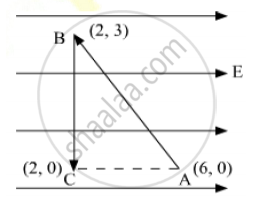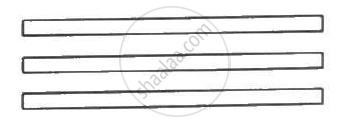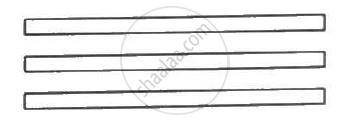Advertisements
Advertisements
प्रश्न
A charge of `+2.0 xx 10^-8 C` is placed on the positive plate and a charge of `-1.0 xx 10^-8 C` on the negative plate of a parallel-plate capacitor of capacitance `1.2 xx 10^-3 "uF"` . Calculate the potential difference developed between the plates.
उत्तर
The charge on the positive plate is q1 and that on the negative plate is q2.
Given :
`q_1 = 2.0 xx 10^-8 C`
`q_2 = -1.0 xx 10^-8 C`
Now ,
Net charge on the capacitor = `((q_1 - q_2))/2 = 1.5 xx 10^-8 C`
The potential difference developed between the plates is given by `q = VC`
⇒ `V = (1.5 xx 10^-8)/(1.2 xx 10^-9)` = `12.5 V`
APPEARS IN
संबंधित प्रश्न
Define 1 volt PD.
Distinguish between Conductors and Insulators.
Draw a labelled diagram of Van de Graaff generator. State its working principle to show how by introducing a small charged sphere into a larger sphere, a large amount of charge can be transferred to the outer sphere. State the use of this machine and also point out its limitations.
A metal rod of square cross-sectional area A having length l has current I flowing through it when a potential difference of V volt is applied across its ends (figure I). Now the rod is cut parallel to its length into two identical pieces and joined as shown in figure II. What potential difference must be maintained across the length of 2l. so that the current in the rod is still I?

Explain the principle of a device that can build up high voltages of the order of a few million volts.
Is there any restriction on the upper limit of the high voltage set up in Van de Graff generator machine? Explain.
A test charge ‘q’ is moved without acceleration from A to C along the path from A to B and then from B to C in electric field E as shown in the figure. (i) Calculate the potential difference between A and C. (ii) At which point (of the two) is the electric potential more and why?

A 100 pF capacitor is charged to a potential difference of 24 V. It is connected to an uncharged capacitor of capacitance 20 pF. What will be the new potential difference across the 100 pF capacitor?
The capacitance between the adjacent plates shown in figure is 50 nF. A charge of 1⋅0 µC is placed on the middle plate. (a) What will be the charge on the outer surface of the upper plate? (b) Find the potential difference developed between the upper and the middle plates.

The capacitance between the adjacent plates shown in the figure is 50 nF. A charge of 1.0µC is placed on the middle plate. If 1.0 µC is placed on the upper plate instead of the middle, what will be the potential difference between (a) the upper and the middle plates and (b) the middle and the lower plates?

Two capacitors of capacitance 20⋅0 pF and 50⋅0 pF are connected in series with a 6⋅00 V battery. Find (a) the potential difference across each capacitor and (b) the energy stored in each capacitor.
Answer the following question:
Find the expression for the resistivity of a material.
The unit of potential difference as used in electrical circuits is ________.
Assertion: Electric potential and electric potential energy are different quantities.
Reason: For a system of positive test charge and point charge electric potential energy = electric potential.
On moving a charge of Q coulomb by X cm, W J of work is done, then the potential difference between the points is ______.
- It depends only on the initial and final position.
- It is the work done per unit positive charge in moving from one point to other.
- It is more for a positive charge of two units as compared to a positive charge of one unit.
A bullet of mass of 2 g is having a charge of 2 µc. Through what potential difference must it be accelerated, starting from rest, to acquire a speed of 10 m/s.
Can there be a potential difference between two adjacent conductors carrying the same charge?
